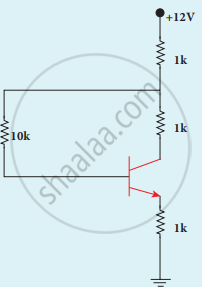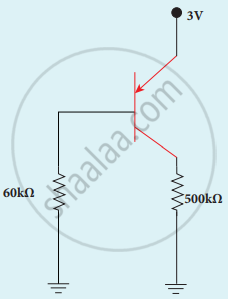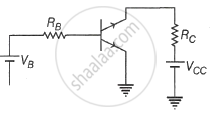Advertisements
Advertisements
प्रश्न
Explain the working of the n-p-n transistor in a common base configuration.
उत्तर

The common base configuration for n-p-n transistor
In a Common Emitter configuration, the emitter of the transistor is common to both the input and the output.
Working:

Biasing of n-p-n transistor
- The majority of charge carriers in the emitter of the n-p-n transistor are electrons.
- In the above figure, the emitter-base junction is forward-biased while the collector-base junction is reverse-biased.
- At the instant when the EB junction is forward biased, electrons in the emitter region have not entered the base region as shown in the below figure.

Injection of majority carriers into base - These electrons can either flow through the base circuit and constitute the base current (IB), or they can also flow through the collector circuit and contribute towards the collector current (IC).
- The base is thin and lightly doped, the base current is only 5% of IE.
- Electrons injected from the emitter into the base diffuse into the collector-base depletion region due to the thin base region. When the electrons enter the collector-base depletion regions, they are pushed into the collector region by the electric field at the collector-base depletion region. collector current (IC) flows through the external circuit as shown in the below figure. The collector's current IC is about 95% of IE.

Electron flow through a transistor - From the above figure, we can conclude that IE = IB + IC. Since the base current IB is very small we can write IC ≈ IE.
APPEARS IN
संबंधित प्रश्न
Why is the base of a transistor made thin and is lightly doped?
Why are the emitter, the base, and the collector of a BJT doped differently?
Which method of biasing is used for operating a transistor as an amplifier?
For a transistor β =75 and IE = 7.5 mA. The value of α is ______
In a transistor amplifier, IC = 5.5 mA , IE = 5.6 mA. The current amplification factor β is ______
Draw the circuit symbol of the PNP transistor.
With the help of a neat diagram, explain the working of the npn transistor?
With the help of a neat circuit diagram, explain the transistor as an amplifier?
The output of the following circuit is 1 when the input ABC is

A transistor of α = 0.99 and VBE = 0.7 V is connected in the common-emitter configuration as shown in the figure. If the transistor is in the saturation region, find the value of collector current.

In the circuit shown in the figure, the BJT has a current gain (β) of 50. For an emitter-base voltage VEB = 600 mV, calculate the emitter-collector voltage VEC (in volts).

If l1, l2, l3 are the lengths of the emitter, base and collector of a transistor, then ____________.
For a transistor, the current ratio 'βdc' is defined as the ratio of ______.
In the symbol for a transistor, the arrow head points in the direction of the ____________.
Least doped region in a transistor ____________.
Ve, Vb, and Ve are emitter, base, and collector voltage respectively for npn transistor in CE mode. Amplifier works for the combination of biasing voltage equal to ______.
If `alpha`-current gain of a transistor is 0.98. What is the value of `beta`- current gain of the transistor?
In a transistor in CE configuration, the ratio of power gain to voltage gain is ____________.
In switching circuit, transistor is in ON state, values of IE and lB are 10 mA and 0.8 mA respectively and RL is 2 k`Omega`. If VCE is 7.6 V, then VCC is ____________.
Which of the following regions of a transistors are, respectively, heavily dopped and lightly dopped?
In a common emitter amplifier circuit using an n-p-n transistor, the phase difference between the input and the output voltages will be: ____________.
A transistor when connected in common emitter mode has a ____________.
A change of 9.0 mA in the emitter current brings a change of 8.9 mA in the collector current. The value of current gain β will be ______.
In the common-emitter configuration of a transistor, the current gain is more than 1 because [lb, le, and lc are base, emitter, and collector currents respectively] ______
A conducting wire has length 'L1' and diameter 'd1'. After stretching the same wire length becomes 'L2' and diameter 'd2' The ratio of resistances before and after stretching is ______.
In a p-n-p transistor circuit, the collector current is 10 mA. If 90% of the holes emitted from the emitter reach the collector, ______.
A common emitter amplifier circuit built using an n-p-n transistor is shown in the figure. Its DC current gain is 300, RC = 4 kΩ and VCC = 20 V. What is the minimum base current for VCE to reach saturation?

The base current in common emitter mode of the transistor changes by 10 µA. If the current gain of the transistor is 50, then change in collector current is ______.
Define peak value of alternating signal.
